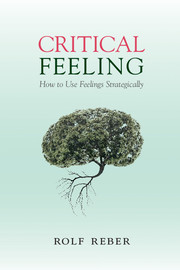Book contents
- Frontmatter
- Dedication
- Contents
- Preface
- Part I The basics of critical feeling
- Part II Applications of critical feeling
- 4 Happiness through critical feeling
- 5 The role of sensory and bodily feedback
- 6 Living together
- 7 Critical feeling in business and politics
- 8 Critical feelings at school
- 9 Music, art, and literature
- 10 Religion and morality
- Epilogue
- Notes
- References
- Index
5 - The role of sensory and bodily feedback
from Part II - Applications of critical feeling
Published online by Cambridge University Press: 05 March 2016
- Frontmatter
- Dedication
- Contents
- Preface
- Part I The basics of critical feeling
- Part II Applications of critical feeling
- 4 Happiness through critical feeling
- 5 The role of sensory and bodily feedback
- 6 Living together
- 7 Critical feeling in business and politics
- 8 Critical feelings at school
- 9 Music, art, and literature
- 10 Religion and morality
- Epilogue
- Notes
- References
- Index
Summary
When love and skill work together, expect a masterpiece.
(Charles Reade 1895/1870, p. 48)The first section of this chapter will take up the main theme of the previous chapter – happiness – and asks the question, “How can we exploit bodily feedback to become happier?” before I discuss a central idea that underpins the importance of critical feeling. If it could be shown that every thought is accompanied by an evaluation, trying to suppress feelings in order to think critically would turn out to be futile – we simply could not do it. Instead, we would need to complement critical thinking with critical feeling.
Observations about how bodily feedback influences affect support the notion that feelings are always with us. I shall review evidence for the claim that each percept, each thought, each action is accompanied by feelings. This view has important consequences for cognitive theories of skill acquisition and execution, as exemplified by the modification of a cybernetic model of action execution and monitoring. Skill learning is plagued by the paradox that smooth learning does not necessarily mean good learning outcomes; moreover, the assessment of skill is notoriously difficult. A final section deals with the role of the body in synchronous movement, a topic that leads to social interaction, which will be the topic of the next chapter.
Bodily feedback and affect
Common sense assumes that people smile when they are happy. However, there is also a commonsense notion that we can reverse this process, that we can make ourselves happy by smiling. “The world always looks brighter from behind a smile,” as the saying goes, and this is indeed what can be shown by psychological research, for example on facial feedback and on feedback from postures (see Laird 2007). According to De Sousa (1987), people can use the expression of happiness as a bootstrap mechanism or shortcut to boost their own happiness. Indeed, facial affective feedback has been shown to be instrumental in judging humorousness (Strack et al. 1988) and in processing emotional language (Havas, Glenberg, Gutowski, Lucarelli, and Davidson 2010). Laird (2007) summarized other studies that provide compelling evidence that emotional expression through facial expressions, posture, breathing patterns, and vocal behavior influences emotional feeling. For example, speaking in a loud, harsh voice increases feelings of anger whereas speaking in a soft, low tone is more likely to result in sad feelings.
- Type
- Chapter
- Information
- Critical FeelingHow to Use Feelings Strategically, pp. 128 - 144Publisher: Cambridge University PressPrint publication year: 2016



